Intel's 10nm Cannon Lake and Core i3-8121U Deep Dive Review
by Ian Cutress on January 25, 2019 10:30 AM ESTStock CPU Performance: Rendering Tests
Rendering is often a key target for processor workloads, lending itself to a professional environment. It comes in different formats as well, from 3D rendering through rasterization, such as games, or by ray tracing, and invokes the ability of the software to manage meshes, textures, collisions, aliasing, physics (in animations), and discarding unnecessary work. Most renderers offer CPU code paths, while a few use GPUs and select environments use FPGAs or dedicated ASICs. For big studios however, CPUs are still the hardware of choice.
All of our benchmark results can also be found in our benchmark engine, Bench.
Corona 1.3: Performance Render
An advanced performance based renderer for software such as 3ds Max and Cinema 4D, the Corona benchmark renders a generated scene as a standard under its 1.3 software version. Normally the GUI implementation of the benchmark shows the scene being built, and allows the user to upload the result as a ‘time to complete’.
We got in contact with the developer who gave us a command line version of the benchmark that does a direct output of results. Rather than reporting time, we report the average number of rays per second across six runs, as the performance scaling of a result per unit time is typically visually easier to understand.
The Corona benchmark website can be found at https://corona-renderer.com/benchmark
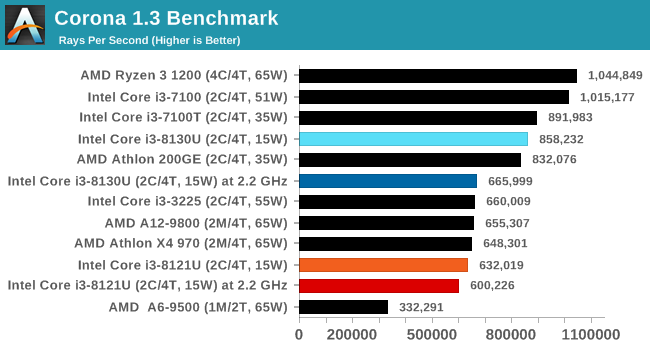
Corona is an AVX2 benchmark, and it would appear that the Cannon Lake CPU can't take full advantage of the functionality. There's still a 10% difference at fixed frequency.
Blender 2.79b: 3D Creation Suite
A high profile rendering tool, Blender is open-source allowing for massive amounts of configurability, and is used by a number of high-profile animation studios worldwide. The organization recently released a Blender benchmark package, a couple of weeks after we had narrowed our Blender test for our new suite, however their test can take over an hour. For our results, we run one of the sub-tests in that suite through the command line - a standard ‘bmw27’ scene in CPU only mode, and measure the time to complete the render.
Blender can be downloaded at https://www.blender.org/download/
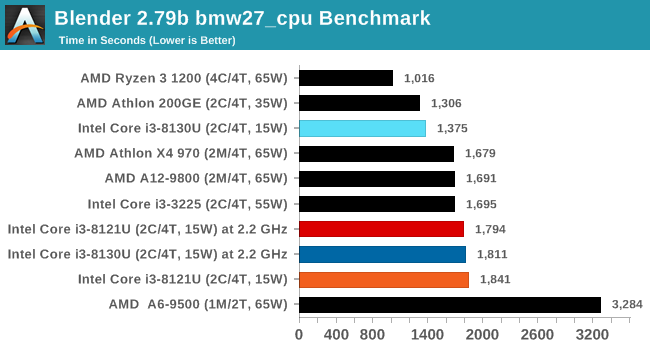
Blender also uses an AVX2 code path, and we see that the CNL processor scored worse at stock settings than at fixed frequency settings. Again, this is likely due to a power or thermal issue.
LuxMark v3.1: LuxRender via Different Code Paths
As stated at the top, there are many different ways to process rendering data: CPU, GPU, Accelerator, and others. On top of that, there are many frameworks and APIs in which to program, depending on how the software will be used. LuxMark, a benchmark developed using the LuxRender engine, offers several different scenes and APIs.
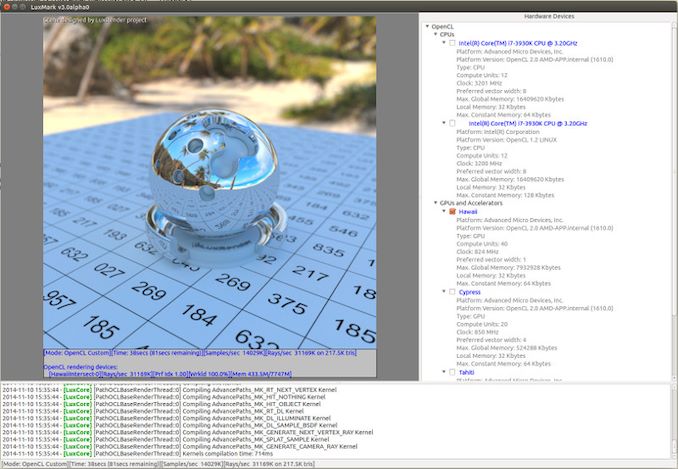
Taken from the Linux Version of LuxMark
In our test, we run the simple ‘Ball’ scene on both the C++ and OpenCL code paths, but in CPU mode. This scene starts with a rough render and slowly improves the quality over two minutes, giving a final result in what is essentially an average ‘kilorays per second’.
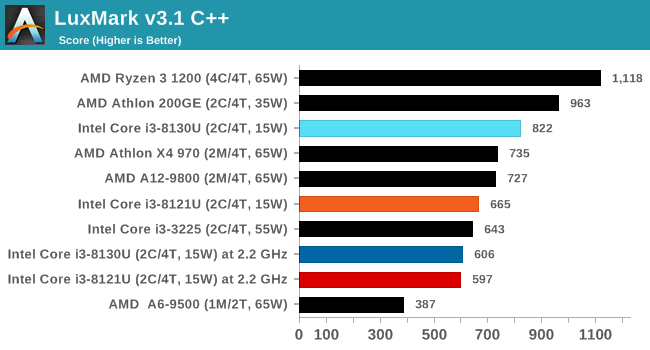
POV-Ray 3.7.1: Ray Tracing
The Persistence of Vision ray tracing engine is another well-known benchmarking tool, which was in a state of relative hibernation until AMD released its Zen processors, to which suddenly both Intel and AMD were submitting code to the main branch of the open source project. For our test, we use the built-in benchmark for all-cores, called from the command line.
POV-Ray can be downloaded from http://www.povray.org/
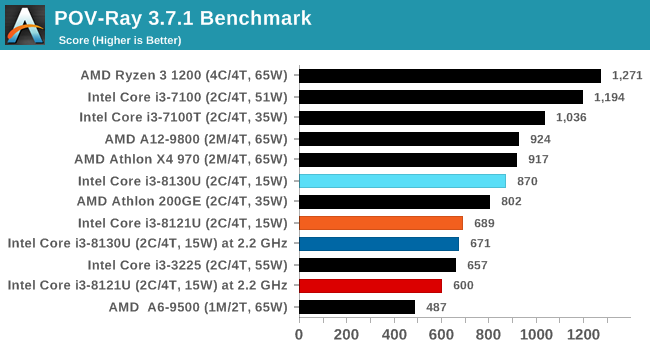











129 Comments
View All Comments
MrCommunistGen - Friday, January 25, 2019 - link
Normally I try to read the whole article (and I *am* looking forward to reading the rest of it) but I already have 2 comments:1. Maybe this review has been in progress for quite a while, but you can definitely buy the NUC8i3CYSM NUC on Amazon, at least in the US. It is shipped and sold by Amazon not some random 3rd party too. It is expensive ($530), and can only be bought with up to 8GB of soldered down RAM, but you can buy it.
2. While the Wi-Fi card is M.2, Lenovo (like HP and others) usually restricts what Wi-Fi cards can be used with a BIOS/UEFI whitelist. I guess this might not apply to a China-only model, but I wouldn't just assume that the card can be upgraded down the line unless you've already verified this is possible.
jaju123 - Friday, January 25, 2019 - link
I would chalk up the system resonsiveness to the GPU and the low screen res. When moving from a Dell XPS 15 9560 laptop with 1080p screen resolution to an otherwise identical 4K model, I noticed a severe loss of performance in the windows UI. The reality is that Intel iGPUs in even kaby lake processors are simply not enough to provide a smooth experience on high res laptops. The 1080p experience was really smooth, however.You can also force certain apps to the use the dedicated nvidia graphics, or simply choose to run at a non-native 1080p and it speeds up the UI drastically.
hansmuff - Friday, January 25, 2019 - link
Wow, this is an excellent article. Packed with knowledge and facts, well written; a real gem. Thank you!FreckledTrout - Friday, January 25, 2019 - link
Its weird to see a dual core even in a laptop on the new 10nm process. I would have expected dual cores to disappear with Intel's 10nm or AMD's 7nm.FreckledTrout - Friday, January 25, 2019 - link
The first dual core laptop came out in 2015 with the AMD Athlon 64 X2 4800 so it's just weird to me 14 years later it's still something being made especially with such a dense process.FreckledTrout - Friday, January 25, 2019 - link
Damn no edit.... in 2005 I meant.jeremyshaw - Friday, January 25, 2019 - link
I think I had one of those in a Sharp laptop. It had horrible VIA S3 graphics, but a beautiful, bright display. It was my last 4:3 laptop, an end of an era for me.Icehawk - Saturday, January 26, 2019 - link
Majority of laptops are still DC, I have to check our laptop orders when we place them to make sure my boss and our vendor aren’t screwing up ordering them.ianmills - Friday, January 25, 2019 - link
Intel probably thought the same as you! Remember the reason this was released was so that Intel could tell its investors it was shipping 10nm partsdanwat1234 - Friday, January 25, 2019 - link
Agreed.